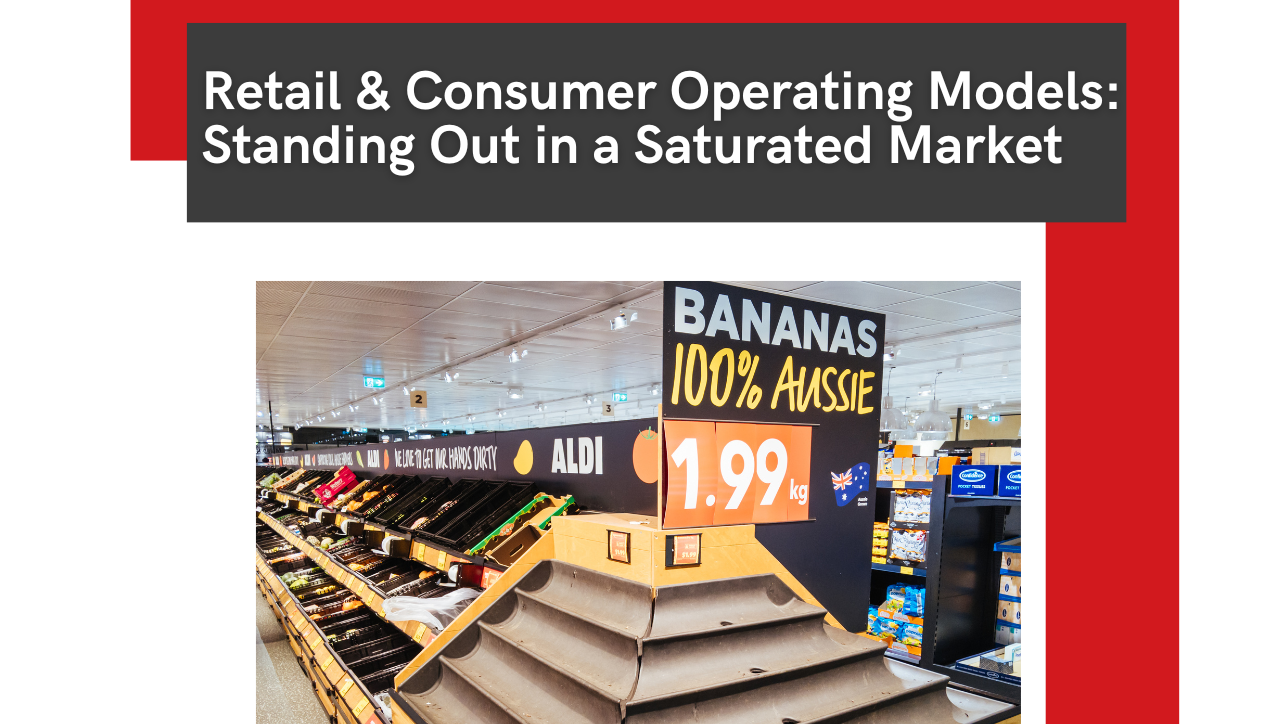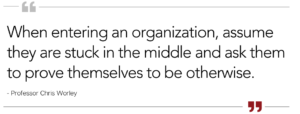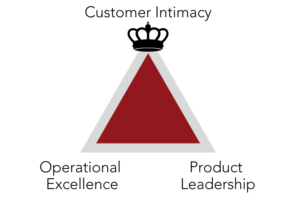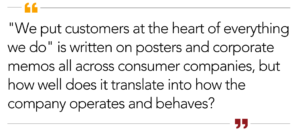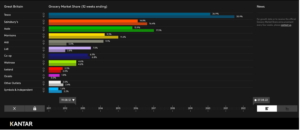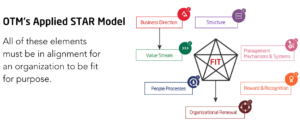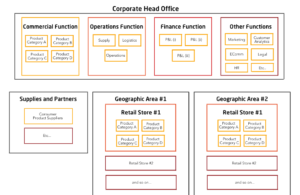5 Minute Read
Takeaway: It’s a tough statement to swallow, but most retail and consumer organizations get in their own way of standing out from the crowd in a saturated market. This is often down to lack of clarity and shared understanding internally about how value is created in the market. This then translates into an operating model that is stuck, or better put, pulled in multiple directions.
Many retail and consumer organizations are finding their once-unique strategy has run its course.
This is happening where multiple businesses have been following a product strategy, where offering a unique best-in-class product/service is the key differentiator. But in many contexts, it has driven the market to become commoditized as the points of differentiation have become so small as to give no discernible value differential. In this environment, organizations then face the choice of competing on cost or following a customer intimate strategy1.
On cost and convenience, there are segments of the market that continue the race to the bottom. Aldi and Lidl expanding from central Europe offered consumers a cheaper product and high convenience. But this strategy has been quickly imitated by grocery competitors, and consumers are back to a decision that goes beyond price. Tesco and Heinz recent price war comes amidst Grocers warning investors that profits will continue to take a hit as they try to absorb price increases in a bid to protect customer loyalty and market share.
When it comes to customer intimacy, consumer organizations have long tangled themselves in knots about what this means in practice.
To be truly customer intimate means knowing more about what the customer needs than they do and responding with products and services that are tailored to their requirements; it requires deep commitment to segmentation and experience. In our experience, the posters, operating model, and behaviors are stuck, jostling between transactional service (just execute the basics), data-driven experience (using customer data in an informed way), and true customer intimacy.
Aside from the big strategic choices, consumer behaviors and sentiments continue to evolve. The ‘Conscious Consumer’ theme is not new, but the characteristics have grown. Primarily due to the explosion of choice in the last decade, with e-commerce growth being one significant influence. Many consumer organizations are frantically analyzing how the consumer is going to evaluate whether they want to shop with them. Additionally, the origin of and conditions in which products are made and the impact to the planet is no longer a fad on the horizon, it’s here to stay.
Organizations are working out what hand they will play in circularity and reusable, extension of life products. Selfridges have committed to half of transactions being resell, repair, rental, or refill by 2030. And Tesco are continuing to experiment with reuse and refill schemes. These are just two examples of consumer organizations experimenting their way to commitments on circularity and sustainable solutions, but it will take a sizeable effort to change both consumer behavior at scale and behaviors up and down their own operating models and supply chain ecosystem.
To illustrate the impact, this graphic from Kantar shows the shift in market share in the last decade in the UK Grocery market.2
Standing Out from the Crowd in a Saturated Market is About Customer Relevance.
Successful competition is enabled by the integrated set of choices that not only define how the organization intends to create value in the market (strategic positioning) but also the operating model choices that enable a competitive position3.
Old marketing gimmicks are fading; one-time events and “washing” consumers with what organizations think the consumer wants to hear are ineffective in building trust and relevance. Consumers have platforms for their opinion, more choices, and more data at their fingertips than ever.
Standing out from the crowd and sustaining relevance requires all parts of the organization to fit and align to a unique, commonly understood and well executed operating model. In OTM’s experience, too many of these organizations are stuck in between strategic positions and multiple interpretations and applications of the operating model lead to significant inefficiencies and lag.
Those that stand out from the crowd do not concern themselves with imitating what everyone else does. They have freed themselves from ways of working that drive internal competition, duplication, and frustration. They focus on their unique outside-in position, and the work they must be great at for consumers to choose them.
Translate How You Create Value (Strategic Positioning) into the Work You Need to be Good at.
Ikea are a good example of a global brand with market clarity. Their strategic position has always been Operational Excellence; it permeates the entire business from product development, through supply chain, to how they set up their stores, service consumer needs and manage the inventory.
Zara compete with their product strategy, with a close-to-equal focus on operational excellence with their highly agile inventory management. Inditex, who own Zara, have built a portfolio of seven brands focused on retaining its consumers throughout their lifetime. Their strategy, both on paper and in practice throughout its operating model, is incredibly clear.
Although how they create value in the market is different, both Ikea and Zara invest significant time, effort and money in core work that gives them their competitive advantage. Inventory management, shopper marketing, and market and consumer intelligence (to be responsive to change) are just three examples. Neither company try to be all things to everyone. To ensure they maximize availability, Ikea must trade-off a personable shopping experience as they choose to deploy their finite resource on inventory management and efforts upstream in their operating model (where the customer can’t always ‘see’ them). There is a deliberate choice rationalization, where the consumer choice is a limited range of colors and finishes of their home furnishings.
Watch out for Operating Model Complication and Symptoms.
It’s a tough statement to swallow, but most retail and consumer organizations get in their own way of standing out from the crowd.
This is often down to lack of clarity and shared understanding internally about how value is created in the market. This then translates into an operating model that is stuck, or better put, pulled in multiple directions.
This simple diagram illustrates some of the design issues a retail organization can face:
The work is organized in different ways within multiple boundaries resulting in competing tensions.
- At store level, departments are organized in product categories (“shop within a shop”), with corporate direction at a commercial product category level
- Each retail store trades to serve its local consumer, with corporate direction on company-wide standards, consistency etc.
- The geographic area is a collection of stores and ecommerce, trading like a mini business within the broader business, with corporate direction from various angles
- Head office, typically organized as functional specialisms, each focused on their part and driving the business forward with what they see and need to act on
Illustratively speaking, you can see how complicated a retail/consumer organization operating model can get. More time is spent coordinating and managing internal operations than is spent servicing the customer or products and services.
This is made more complicated if the fundamental decisions are not clear.
Whilst the internal tensions continue, consumer goods organizations (B2B Suppliers) are desperately trying to service their products through the supply chain. They have detailed and specialist knowledge of the consumer who shops in their specific product category, and they are desperate to integrate that data into the retail organization to drive consumer relevance, sales, and market share.
The big so what is the time horizon these organizations operate within are relatively short. External drivers such as product trends, the four seasons and the weather can have an immediate impact on the operating model. This puts real pressure on short term reactions and longer-term strategic planning and positioning.
Aside from clarity on market value, forecasting, inventory management, shopper marketing and consumer intelligence are critical aspects of value creating work that the likes of Ikea and Zara double down on in such a saturated market. Their third point of competitive advantage is how they choose to organize the work for maximum efficiency and agility in coordinating and executing across the entire business; globally, regionally, and locally.
Processing information and decisions through the operating model is something that must be a finely tuned part of the management operating system in retail and consumer organizations. However, organizations with significant internal complication and lack of clarity on how they create value may experience large lag times implementing changes in product, promotion, or broader proposition as a result. This highlights the critical requirement to stand out from the crowd: be clear on how you create value in the market and translate that through every design decision in setting up your operating model, and the mechanisms required to maintain discipline in execution.
References:
1 Customer intimacy is not the same as customer focus
2 Kantar World Panel – Grocery Market Share
3 Design cannot begin until you’re clear on strategic position
4 Knowing when to change your operating model
Chris Furnell is a Senior Consultant at ON THE MARK. OTM is a global leader in collaborative operating model modernization that creates real change, fast. OTM’s passion for collaborative business transformation is supported by pragmatism, systems thinking, and a belief in people that is unparalleled for 33 years.

